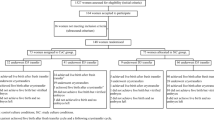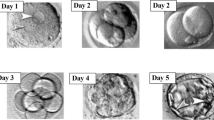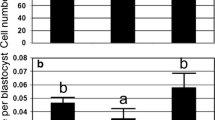Abstract
Purpose
To investigate whether high relative humidity conditions (HC), when using a time-lapse system (TLS) with sequential culture media, are beneficial to embryo culture, improving ongoing pregnancy rates.
Methods
We included patients undergoing their first ICSI cycle treatment from April 2021 to May 2022. Patients assigned to dry conditions (DC) or HC were 278 and 218, respectively. We used a GERI TLS, three chambers configured in humidity conditions and three in dry conditions. The effect of HC on ongoing pregnancy rate was assessed by the propensity matched sample, to reduce potential differences between women undergoing either HC or DC and reduce biased estimation of treatment effect.
Result
After adjusting for several confounding variables and applying the propensity score (PS), no significant differences were observed in the rates of normal (2PN) and abnormal (1PN and 3PN) fertilization, blastulation, top-quality blastocysts, frozen blastocysts, ongoing pregnancies, and miscarriages. The 2-cell (t2) and 4-cell (t4) stages and cell divisions between such stages occurred earlier and were more synchronous in the in DC.
Conclusion
These results suggest that HC conditions do not improve the rate of ongoing pregnancy and several embryological outcomes, under the conditions used in this study based on a time-lapse system and sequential culture with day 3 medium change-over.
Similar content being viewed by others
References
ESHRE Guideline Group on Good Practice in IVF Labs, De los Santos MJ, Apter S, Coticchio G, Debrock S, Lundin K, et al. Revised guidelines for good practice in IVF laboratories (2015). Hum Reprod. 2016;31(4):685–6.
Wale PL, Gardner DK. The effects of chemical and physical factors on mammalian embryo culture and their importance for the practice of assisted human reproduction. Hum Reprod Update. 2016;22(1):2–22.
Swain JE, Carrell D, Cobo A, Meseguer M, Rubio C, Smith GD. Optimizing the culture environment and embryo manipulation to help maintain embryo developmental potential. Fertil Steril. 2016;105(3):571–87.
Esteves SC, Bento FC. Implementation of air quality control in reproductive laboratories in full compliance with the Brazilian Cells and Germinative Tissue Directive. Reprod Biomed Online. 2013;26(1):9–21.
Kleijkers SHM, van Montfoort APA, Bekers O, Coonen E, Derhaag JG, Evers JLH, et al. Ammonium accumulation in commercially available embryo culture media and protein supplements during storage at 2-8°C and during incubation at 37°C. Hum Reprod. 2016;31(6):1192–9.
Geraghty RJ, Capes-Davis A, Davis JM, Downward J, Freshney RI, Knezevic I, et al. Guidelines for the use of cell lines in biomedical research. Br J Cancer. 2014;111(6):1021–46.
Swain JE. Decisions for the IVF laboratory: comparative analysis of embryo culture incubators. Reprod Biomed Online. 2014;28(5):535–47.
Holmes R, Swain JE. Humidification of a dry benchtop IVF incubator: impact on culture media parameters. Fertil Steril. 2018;110(4):e52–3.
Swain JE, Graham C, Kile R, Schoolcraft WB, Krisher RL. Media evaporation in a dry culture incubator; effect of dish, drop size and oil on media osmolality. Fertil Steril. 2018;110(4):e363–4.
Mestres E, García-Jiménez M, Casals A, Cohen J, Acacio M, Villamar A, et al. Factors of the human embryo culture system that may affect media evaporation and osmolality. Hum Reprod. 2021;36(3):605–13.
Fawzy M, AbdelRahman MY, Zidan MH, Abdel Hafez FF, Abdelghafar H, Al-Inany H, et al. Humid versus dry incubator: a prospective, randomized, controlled trial. Fertil Steril. 2017;108(2):277–83.
Chi HJ, Park JS, Yoo CS, Kwak SJ, Son HJ, Kim SG, et al. Effect of evaporation-induced osmotic changes in culture media in a dry-type incubator on clinical outcomes in in vitro fertilization-embryo transfer cycles. Clin Exp Reprod Med. 2020;47(4):284–92.
Valera MA, Albert C, Marcos J, Larreategui Z, Bori L, Meseguer M. A propensity score-based, comparative study assessing humid and dry time-lapse incubation, with single-step medium, on embryo development and clinical outcomes. Hum Reprod. 2022;37(9):1980–93.
World Health Organization. WHO Laboratory manual for the examination and processing of human semen. 5. Geneva: World Health Organization; 2010.
Tarozzi N, Nadalini M, Bizzaro D, Serrao L, Fava L, Scaravelli G, et al. Sperm-hyaluronan-binding assay: clinical value in conventional IVF under Italian law. Reprod Biomed Online. 2009;19(Suppl 3):35–43.
Borini A, Bonu MA, Coticchio G, Bianchi V, Cattoli M, Flamigni C. Pregnancies and births after oocyte cryopreservation. Fertil Steril. 2004;82(3):601–5.
Borini A, Bafaro MG, Bianchi L, Violini F, Bonu MA, Flamigni C. Oocyte donation programme: results obtained with intracytoplasmic sperm injection in cases of severe male factor infertility or previous failed fertilization. Hum Reprod. 1996;11(3):548–50.
Alpha Scientists in Reproductive Medicine and ESHRE Special Interest Group of Embryology. The Istanbul consensus workshop on embryo assessment: proceedings of an expert meeting. Hum Reprod. 2011;26(6):1270–83.
Rosenbaum PR, Rubin DB. The central role of the propensity score in observational studies for causal effects. Biometrika. 1983;70(1):41–55.
Lagalla C, Bartolacci A, Coticchio G, Intra G, Dell'Aquila M, Parodi M, Patria G, Zacà C, Borini A. Embryo culture under high humidity conditions in time lapse system does not improve ongoing pregnancy rates: a retrospective propensity score model study 299 ICSI cycles. Hum Reprod. 2022; Issue Supplement 1, July 2022
Del Gallego R, Albert C, Marcos J, Larreategui Z, Alegre L, Meseguer M. Humid vs. dry embryo culture conditions on embryo development: a continuous embryo monitoring assessment. Fertil Steril. 2018;110(4):e362–3.
Yumoto K, Iwata K, Sugishima M, Yamauchi J, Nakaoka M, Tsuneto M, et al. Unstable osmolality of microdrops cultured in non-humidified incubators. J Assist Reprod Genet. 2019;36(8):1571–7.
Scarica C, Monaco A, Borini A, Pontemezzo E, Bonanni V, De Santis L, et al. Use of mineral oil in IVF culture systems: physico-chemical aspects, management, and safety. J Assist Reprod Genet. 2022;39(4):883–92.
Funding
The study was funded by the authors’ institution.
Author information
Authors and Affiliations
Corresponding author
Ethics declarations
Conflict of interest
The authors declare no competing interests.
Additional information
Publisher’s note
Springer Nature remains neutral with regard to jurisdictional claims in published maps and institutional affiliations.
Rights and permissions
Springer Nature or its licensor (e.g. a society or other partner) holds exclusive rights to this article under a publishing agreement with the author(s) or other rightsholder(s); author self-archiving of the accepted manuscript version of this article is solely governed by the terms of such publishing agreement and applicable law.
About this article
Cite this article
Bartolacci, A., Borini, A., Cimadomo, D. et al. Humidified atmosphere in a time-lapse embryo culture system does not improve ongoing pregnancy rate: a retrospective propensity score model study derived from 496 first ICSI cycles. J Assist Reprod Genet 40, 1429–1435 (2023). https://doi.org/10.1007/s10815-023-02818-8
Received:
Accepted:
Published:
Issue Date:
DOI: https://doi.org/10.1007/s10815-023-02818-8




